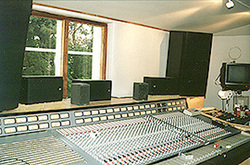ToTo Man
the band not the dog
Nothing stops bass modes, the best you can hope to achieve is to ameliorate them to the point that you can live with them. I've managed to control my bass modes down to frequencies of 50Hz to a satisfactory level with room treatment alone. My 40Hz axial length bass mode is still problematic and I'm told would require treating the entire front and rear wall with 40cm deep absorption. I'm not in a position to do this, but if I was then I would, because at the moment I am confined to sitting in the middle 20% of my room. If I move forward or backward any more than this, the 40Hz boom becomes intrusive and gives me a headache. Not a problem most of the time because I have the sweet spot all to myself but when I (occasionally!) have guests I need to sit 3 feet behind the sweet spot and it isn't a pleasant experience! I could, of course, EQ the 40Hz mode to make it more tolerable in the 'back row' but that would be at the expense of my guests sat in the 'front row'!I have GIK bass traps. They do NOT stop bass nodes in a room.
DEQ is my solution.
The only other really viable options are a different room, or speakers that don’t go low enough to set off the peak node.
Last edited:



